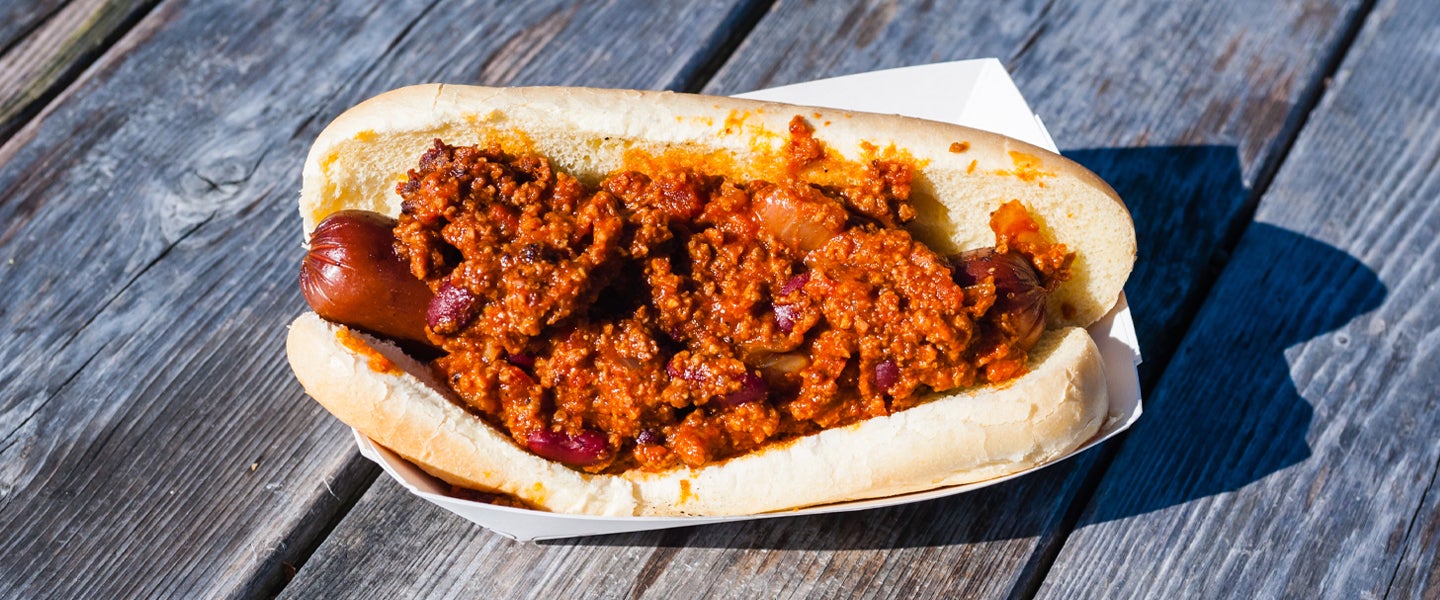The National Hot Dog and Sausage Council (it’s a real thing!) estimates that the majority of hot dogs consumed by Americans each year are devoured between Memorial Day and Labor Day, with 7 billion hot dogs slithering their way through Americans’ digestive tracts. Some of these, inevitably, will be chili dogs, which follow in that fine American tradition of finding ever-more inventive ways to shove more meat into our bodies at once.
Professional eater Randy Santel has probably eaten a huge chunk of those 7 billion dogs (and chili dogs) each year, thanks to the 829 food challenges he’s done across America and 37 other countries. One of his more memorable record achievements was set in 2015 at Gus’s Hotdogs in Watervliet, New York, where he polished off 50 mini chili dogs in 21 minutes. “The good thing about chili dogs is the liquidity helps the food go down,” Santel says. “Chili dog contests are actually a lot of fun for people who do them.”
Santel, of course, is a professional who knows his body and the health risks involved with such large quantities of food, so he prepares like crazy for a feat like this, taking digestive enzymes before matches, limiting or eliminating meals before and after matches and sticking to a diet and exercise routine in between competitions. “It can be really hard on your stomach because you’re not really biting or chewing too much,” he says. “You pretty much just bite each hot dog three times and swallow.”
But what sort of havoc are they wreaking, exactly?
For this, I turned to Cate Shanahan, an author and physician who’s created nutrition programs for the L.A. Lakers and who works as the director of metabolic health for ABC Fine Wine and Spirits in Orlando. Shanahan tells me the effects that chili dogs can have on humans who aren’t trying to set world eating records really depend on where you got that chili dog from. Inevitable ingredients like salt and saturated fat aren’t necessarily going to mess you up if you’re relatively healthy and they’re not a regular indulgence — the real culprits hiding in most chili dogs are the high polyunsaturated fats from certain oils she calls “The Hateful Eight,” a group of oils including canola, corn, cottonseed, soy, sunflower, safflower, grapeseed and rice bran oils.
“If we’re talking about making it from scratch, make sure you use good fat if you’re going to be using oil,” she says. “Saturated fat is actually better. Polys promote inflammation — whenever you’re cooking, you want to avoid them. If you want to have a healthy chili dog, you can — just use good quality hot dogs. They even have 100 percent grass-fed hot dogs.” She also recommends just grilling hot dogs for your chili dogs so it’s easier to avoid these oils.
As for what they actually do, the inflammation from polyunsaturated fats can turn your digestive trail, from start to finish, into an uncomfortable hellfire. The spices also have the potential to irritate things, but Shanahan says that since spices themselves are actually superfoods due to their high mineral content, it’s really the oils that are doing you the dirty. “If you’ve got nasty oils in there promoting inflammation in your esophagus, stomach and intestines, you’re more likely to get heartburn,” Shanahan says. “A lot of people think it’s the spices, but the oils in combination with the spices can promote inflammation. If you take away the oils, you can have all the spices you want.”
Store-bought and restaurant chili and bean sauces are also likely to contain sugar that Shanahan says can promote the growth of pathogenic bacteria in your stomach. This collection of bad bacteria can, over time, weaken your immune system and make you more susceptible to nasty viruses like e.coli or even the coronavirus. They can cause a serious case of sepsis as well, which can turn your immune system against your body’s natural functions. “It depends on how you make the chili, but if you go to a drive-thru and get some Sonic or whatever, over time, that’s what causes heart disease — the bad fat,” Shanahan says.
For a better option, Shanahan recommends adding healthier ingredients to the chili, such as onions that haven’t been sautéed in oil, and limiting the amount of sugar in it. “Just use a low-sugar bean sauce or don’t add that much sugar,” she says. “A couple of tablespoons is enough to give it a sweet, little edge.”
So try it. Your asshole will thank you later.
